Science & Technology - 2014
July
International Team Conducts First Collisionless Shock Experiment on NIF
The first NIF Discovery Science experiment designed to create and study fully formed collisionless shocks, such as those responsible for the properties of many astrophysical phenomena including supernova remnants, gamma-ray bursts, jets from active galactic nuclei, and cosmic ray acceleration, was performed on July 29.
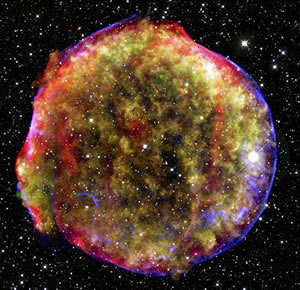 Chandra X-ray Observatory photo of the Tycho supernova remnant discovered by astronomer Tycho Brahe in 1572. The supersonic expansion of the exploded star produced a shock wave moving outward into the surrounding interstellar gas. A reverse shock wave racing back into the expanding stellar debris at Mach 1000 (1,000 times the speed of sound) is heating the debris to millions of degrees (red and green) and causing it to emit x-ray light. The thin shock layer on the edge is considered to be from collisionless shocks. Weibel instabilities generate magnetic fields that trap the ions and form the initial shocks, which play an important role in cosmic ray acceleration and magnetic field amplification. Laser experiments can explore the micro-physics related to these astrophysical phenomena.(Credit: NASA/CXC/SAO)
Chandra X-ray Observatory photo of the Tycho supernova remnant discovered by astronomer Tycho Brahe in 1572. The supersonic expansion of the exploded star produced a shock wave moving outward into the surrounding interstellar gas. A reverse shock wave racing back into the expanding stellar debris at Mach 1000 (1,000 times the speed of sound) is heating the debris to millions of degrees (red and green) and causing it to emit x-ray light. The thin shock layer on the edge is considered to be from collisionless shocks. Weibel instabilities generate magnetic fields that trap the ions and form the initial shocks, which play an important role in cosmic ray acceleration and magnetic field amplification. Laser experiments can explore the micro-physics related to these astrophysical phenomena.(Credit: NASA/CXC/SAO) Studying astrophysics with laboratory experiments can help answer questions about micro-physics in astrophysical objects that are far beyond the reach of direct measurements. Most shock waves in astrophysics are collisionless from high plasma flow velocities—they form due to plasma instabilities and self-generated magnetic fields. Laser-driven plasma experiments can study the micro-physics of plasma interaction and instability formation (known as filamentary Weibel instability) under controlled conditions. NIF is the only facility that can create the proper plasma conditions to generate fully formed collisionless shocks and strong magnetic fields.
The NIF experiment, conducted by an international team of physicists comprising the Astrophysical Collisionless Shock Experiments with Lasers (ACSEL) campaign, builds on simulations and a number of previous experiments at the University of Rochester’s OMEGA Laser Facility. It was designed to investigate high-Mach-number non-relativistic collisionless shock formations. The experiment also collected data for the study of self-generated magnetic fields from the Weibel instability in counter-streaming plasma flows, and magnetic field generation and amplification in turbulent flows.
Supported by LLNL’s Hye-Sook Park and Steven Ross, the ACSEL team used the NIF lasers to irradiate the inner surface of two deuterated plastic foils doped with iron and nickel to create high-velocity counter-streaming plasmas. All 60 requested NIF beams delivered 307 kilojoules (kJ) of 3ω (ultraviolet) light to the targets in a 64.5-terawatt (TW) peak power pulse. The two resulting plasmas interacted at high velocity in a collisionless shock.
Neutron-yield diagnostics and x-ray spectral and imaging diagnostics were tested to evaluate the interaction region of the two counterpropagating plasma discs. Stimulated Raman scattering was measured from four laser probe beams.
“The experiment yielded excellent results,” Park said. “The team observed a high number of neutrons and observed that neutrons came at a relatively late time, which may indicate that they were produced in a shock. We also observed strong x-ray brightening from hot plasmas in the center of the experiment that had never been seen previously. The backscatter measurements delivered good results as well.”
 (Left) The collisionless shock target, consisting of two opposed nickel/iron-doped deuterated plastic (CD) discs; plasma from the discs is accelerated by 28 NIF beams each to counterpropagate and interact at high velocity. (Right) Schematic of the 60 beams interacting with the target and the resulting plasma interaction: 28 beams (150 kJ) on each target plus four full aperture backscatter station (FABS) probe beams to measure stimulated Raman scattering.
(Left) The collisionless shock target, consisting of two opposed nickel/iron-doped deuterated plastic (CD) discs; plasma from the discs is accelerated by 28 NIF beams each to counterpropagate and interact at high velocity. (Right) Schematic of the 60 beams interacting with the target and the resulting plasma interaction: 28 beams (150 kJ) on each target plus four full aperture backscatter station (FABS) probe beams to measure stimulated Raman scattering. Park added that the suite of diagnostics in the experiment performed extremely well, producing a copious amount of data that is now being processed. “With the neutron yield, the delayed neutron production and the x-ray brightening, we are studying whether these signals could be consistent from the shock,” she said. “However, the team needs to confirm these results with physics ‘controlled reference’ shots with a single disc and non-deuterated discs. These shots are planned for this fall. Self-generated magnetic field measurements from the collisionless shock will be done when proton backlighter capability is available on NIF next year.”
The ACSEL collaboration is led by LLNL, Osaka University, Oxford University, Princeton University, and MIT, with many other universities participating.
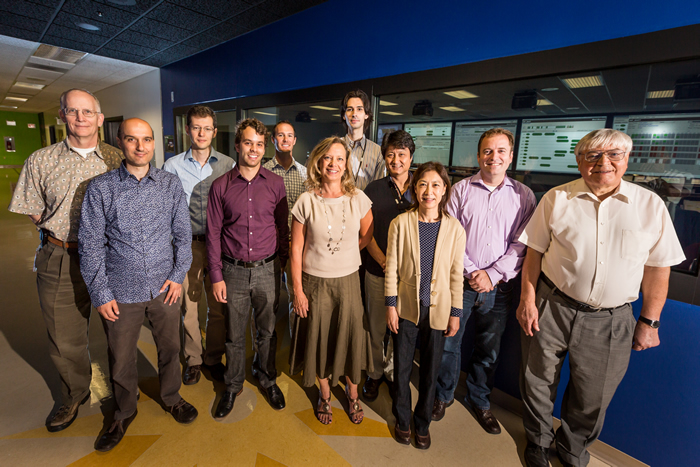 Members of the ACSEL Campaign Team (from left): Bruce Remington (LLNL), Gianluca Gregori (Oxford University), Anatoly Spitkovsky (Princeton University), Frederico Fiuza (LLNL), Channing Huntington (LLNL), Peg Folta (NIF User Office), Matthew Levy (LLNL), Youichi Sakawa (Osaka University), Hye-Sook Park (LLNL), Steven Ross (LLNL), and Dmitri Ryutov (LLNL).
Members of the ACSEL Campaign Team (from left): Bruce Remington (LLNL), Gianluca Gregori (Oxford University), Anatoly Spitkovsky (Princeton University), Frederico Fiuza (LLNL), Channing Huntington (LLNL), Peg Folta (NIF User Office), Matthew Levy (LLNL), Youichi Sakawa (Osaka University), Hye-Sook Park (LLNL), Steven Ross (LLNL), and Dmitri Ryutov (LLNL). Nature Cover Story Reports on NIF Experiments Peering Into Giant Planets
Lawrence Livermore scientists have, for the first time, experimentally recreated the conditions that exist deep inside giant planets, such as Jupiter, Saturn, and many of the planets recently discovered outside our solar system.
Researchers can now recreate and accurately measure material properties that control how these planets evolve over time, information essential for understanding how these massive objects form. 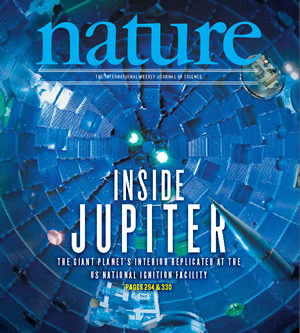 This study focused on carbon, the fourth most abundant element in the cosmos (after hydrogen, helium, and oxygen) with an important role in many types of planets within and outside our solar system. The research appears in the July 17 edition of the journal Nature.
This study focused on carbon, the fourth most abundant element in the cosmos (after hydrogen, helium, and oxygen) with an important role in many types of planets within and outside our solar system. The research appears in the July 17 edition of the journal Nature.
Using the largest laser in the world, the National Ignition Facility, teams from Lawrence Livermore National Laboratory (LLNL), the University of California, Berkeley, and Princeton University squeezed samples to 50 million times Earth’s atmospheric pressure, comparable to the pressures at the center of Jupiter and Saturn. Of the 192 lasers at NIF, the team used 176 with exquisitely shaped energy versus time to produce a continually increasing, albeit shockless pressure wave until the last instant of the experiment, where the pressure wave steepens to produce a massive shock, causing the sample to vaporize. The whole experiment lasts 20 billionths of a second.
Though diamond is the least compressible material known, the researchers were able to compress it to an unprecedented density, greater than lead at ambient conditions.
“The experimental techniques developed here provide a new capability to experimentally reproduce pressure-temperature conditions deep in planetary interiors,” said Ray Smith, LLNL physicist and lead author of the paper.
Such pressures have been reached before only with shock waves that also create high temperatures—hundreds of thousands of degrees or more—that are not realistic for planetary interiors. The technical challenge was keeping temperatures low enough to be relevant to planets. The problem is similar to moving a plow slowly enough to push sand forward without building it up in height. This was accomplished by carefully tuning the rate at which the laser intensity changes with time.
“This new ability to explore matter at atomic scale pressures, where extrapolations of earlier shock and static data become unreliable, provides new constraints for dense matter theories and planet evolution models,” said Rip Collins, another Lawrence Livermore physicist on the team.
The data described in this work are among the first tests for predictions made in the early days of quantum mechanics, more than 80 years ago, routinely used to describe matter at the center of planets and stars. While agreement between these new data and theory are good, there are important differences discovered, suggesting potential hidden treasures in the properties of diamond compressed to such extremes. Future experiments on NIF are focused on further unlocking these mysteries.
Using Lasers to Improve Welding Efficiency
Cdr. Brad Baker, assistant professor of mechanical engineering at the United States Naval Academy, recently completed a six-week stint at LLNL as part of the Visiting Scientist Program. Baker has conducted research in conjunction with Livermore for more than three years, including a material characterization study of nuclear materials and joining methods. This summer, a project focused on laser-assisted friction stir welding brought him to the Lab.
“This was a chance to take the Lab’s laser expertise and combine it with a welding technique called friction stir welding, a technique that the Lab is interested in and that I have experience in applying,” Baker said. “We are trying to merge those two technologies and create a technology called diode laser-assisted friction stir welding. If we can heat the material up first with lasers, the process may become more efficient.”
Friction stir welding is a solid-state joining process used to fuse two metal surfaces. A welding tool generates heat that creates a soft border on each metal piece, allowing the two to be mechanically intermixed and fused together without melting. This expertise, paired with the Lab’s long history of leadership in lasers, creates the basis for a well-executed exploration of combining the two technologies.
Increased efficiency in friction stir welding could have a big impact on the world at large. The technology is a major driver in the automotive, aerospace and oil industries, in addition to military applications. Even Apple applies the technology to its products, incorporating friction stir welding into the newest iMacs for “seamless design.”
During his time at LLNL, Baker worked with Ibo Matthews, the lead scientist studying laser-matter interactions and laser processing of materials. “We study a lot of laser-matter interaction problems for NIF and other applications, one of which involves using high-power lasers to process optics and repair laser-induced damage,” Matthews said. “We’re also exploring laser-assisted manufacturing projects, and this project fits right into what we’re doing. In particular, we are interested in the material response cause by lasers—heating, heat transport and evaporation—that are appropriate for this project.
“We have a history of laser research and development, so Livermore is a natural fit for laser-assisted processing,” he added.
 (Above) Cdr. Brad Baker (right) and Ibo Matthews adjust a 795-nanometer, four-kilowatt continuous wave diode laser array in the Bldg. 272 optics lab. The laser array was used to preheat and test heat transfer on a plate of HY80 steel often used in submarines and ships. (Below) The researchers examine a readout of the test results. (Credit: Jim Pryatel)
(Above) Cdr. Brad Baker (right) and Ibo Matthews adjust a 795-nanometer, four-kilowatt continuous wave diode laser array in the Bldg. 272 optics lab. The laser array was used to preheat and test heat transfer on a plate of HY80 steel often used in submarines and ships. (Below) The researchers examine a readout of the test results. (Credit: Jim Pryatel)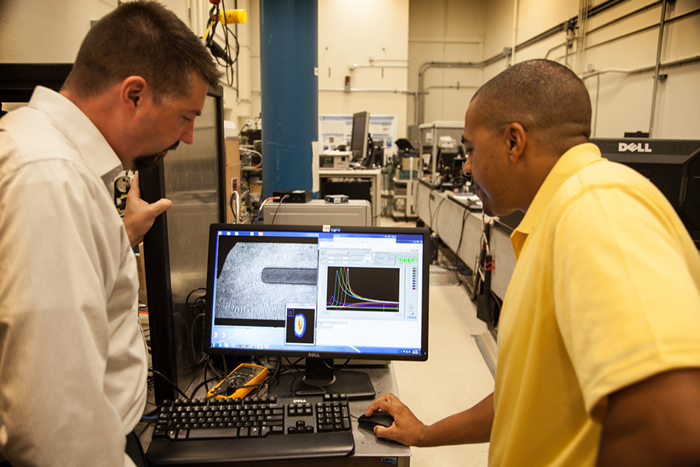
Friction stir welding uses large drill bits to drive the process. These bits are expensive ($5-10,000 per bit) and wear out quickly. By using lasers to heat the material prior to welding, the photon-assisted process may move faster and reduce tool wear.
This summer, Baker and Matthews tested the heat transfer on HY-80, a steel alloy that is often used in naval applications for submarines and ships. The experimental results matched theoretical models well, leading to increased confidence for future testing.
In the next phase of the research, Baker will work out of the Naval Surface Warfare Center–Carderock Division to marry the laser and friction stir welding technologies and continue to prove out the models. “We are fairly certain that this technology will work, but we want to explore the value,” Baker said. “Does it reduce tool wear? Does it weld faster? If we’re able to do those things, we’ll look to see how the combined technology can be optimized.”
The project was funded by LLNL’s Office of Strategic Outcomes.
NIF&PS Researchers Win Two R&D 100 Awards
A new optical polishing technique and technology that allows smaller laser beams to be combined into a single beam have received 2014 R&D 100 Awards. Awarded annually by R&D Magazine and known as the “Oscars of Invention,” the awards recognize cutting-edge scientific and engineering technologies with commercial potential. This year’s awards, among four won by LLNL, increase the total captured by NIF&PS and its predecessor, the Laser Programs Directorate, to 61 since 1978. This year’s awards went to:
A new technique for polishing glass optics: Lab scientists and engineers have developed a new method of optical polishing, termed “convergent polishing,” for improving the polishing and finishing of NIF optics. The new technique is capable of finishing flat and spherical glass optics in a single iteration, regardless of the workpieces’ initial shape.
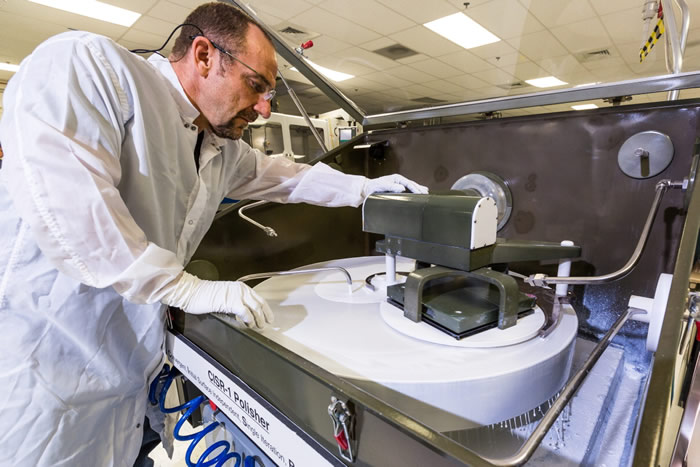 LLNL chemist Rusty Steele operates the “Convergent, Initial surface independent, Single iteration, Rogue-particle free” (CISR) polisher.
LLNL chemist Rusty Steele operates the “Convergent, Initial surface independent, Single iteration, Rogue-particle free” (CISR) polisher. Conventional full-aperture polishing methods for glass optics require multiple, often time-consuming, iterative cycles involving polishing, metrology and process changes to achieve the desired surface figure. Highly skilled master opticians must supervise the fabrication of conventional precision optics. The LLNL-developed convergent polishing technique provides a faster, lower-cost finishing process through a combination of process step and process time reductions. With the new technique, a final workpiece can be completed within a single work shift without operator intervention. The convergent polishing system also provides high workpiece quality, such as for use as laser optics.
The technology received internal “seed money” from the Laboratory Directed Research & Development (LDRD) Program. Winning team members are: Tayyab Suratwala, Rusty Steele, Michael Dennis Feit, Rebecca Dylla-Spears, Dan Mason, Richard Desjardin, Lana Wong, Paul Geraghty, Nan Shen, Phil Miller, Doug Fisher, John Bigelow and Edwin Northcutt.
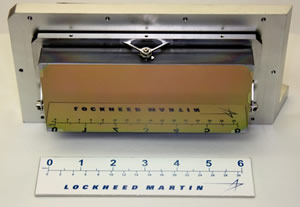 The EXUDE optical element.
The EXUDE optical element. New optical element allows laser beams to be combined: An optical technology developed by LLNL scientists and two industrial partners allows the beams from many small lasers to be combined to produce a single higher-power beam with unprecedented beam quality and electrical efficiency. Called the “Extreme-power, Ultra-low-loss, Dispersive Element (EXUDE),” the technique enables the separate wavelengths of the smaller lasers to be superimposed into an electrically efficient, single-output laser system.
EXUDE was developed and demonstrated in a partnership with Bothell, Washington-based Lockheed Martin Laser and Sensor Systems, and Boulder, Colorado-based Advanced Thin Films. Using the EXUDE optical element, Lockheed Martin has successfully combined multiple fiber lasers into a single 30-kilowatt beam of light, creating the highest-power laser yet that has been able to maintain excellent efficiency and beam quality. Possible applications include defense uses and in material processing, such as marking, cutting, welding and drilling.
The collaboration combined the optical component development capabilities of LLNL with the fiber laser expertise of Lockheed Martin and the low-loss optical coatings of Advanced Thin Films. Winning team members are Jerry Britten, Hoang Nguyen, Michael Aasen, Thomas Carlson, Curly Hoaglan, Cindy Larson and James Nissen.



